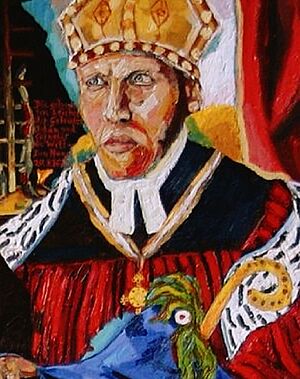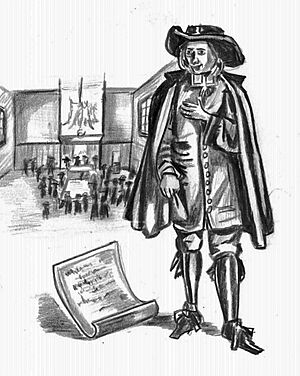Herman op den Graeff facts for kids
Quick facts for kids Herman op den Graeff |
|
|---|---|
| leader of the Mennonites | |
| Personal details | |
| Born | 26 November 1585 Aldekerk, Germany |
| Died | 27 December 1642 (aged 57) Krefeld, Germany |
| Nationality | Dutch |
| Denomination | Christianity |
| Occupation | Linen weaver |
| Profession | merchant |

Herman op den Graeff (born November 26, 1585, in Aldekerk – died December 27, 1642, in Krefeld) was an important leader of the Mennonite community in Krefeld, Germany. He was a linen weaver and merchant.
Contents
Herman op den Graeff's Life
Early Life and Family
Herman op den Graeff was the first known member of the Op den Graeff family. He was born in 1585 into a Mennonite family in Aldekerk, Germany. This area was close to the Dutch border.
The Op den Graeff family is thought to have come from the Netherlands. Some stories suggest a connection to a Duke, but there is no real proof. Another family story connects them to the Von Graben family, but this also cannot be proven.
Moving to Krefeld
In 1605, Herman moved to Kempen. There, he married Greitgen Pletjes on August 6, 1605. A few years later, in 1609, Herman and his family moved to Krefeld.
Leader of the Krefeld Mennonites
In Krefeld, Herman op den Graeff became a lay preacher and a respected leader of the Mennonite community. Mennonites are a Christian group known for their peaceful beliefs and simple lifestyle.
Op den Graeff Windows
Around 1630, Herman and his wife Greitgen had two special stained glass windows made. These windows were called the "Op den Graeff windows." They showed paintings and religious sayings. They were a sign of their strong faith.
The windows were first in Herman's house in Krefeld. Later, they were moved to the Kaiser-Wilhelm-Museum and then to Burg Linn in Krefeld. Sadly, the windows were stolen during World War II. The windows that exist today are not exactly the same as the originals.
Here are some images of the Op den Graeff windows:
One of the sayings on the original windows was:
- "God is fruitful, devout and good to all sides, talked cheerfully and Kind. I am christian and appeal to the Lord. I bring affection, and one grants great honor to me. Herman op Den Graff and Greitgen his wife. Anno 1630"
Another part of the window, which is now missing, had this text:
- "Who will take from us God's love, sorrow or fear or persecution or execution or sword? As written in your will, we are being destroyed all day long. We are looked upon as sheep to be slaughtered. But we overcome all for the one will who has loved us. Romans Chapter 8, Verse 35"
Coat of Arms
There is a possible coat of arms linked to Herman op den Graeff. It is described as a silver swan on a blue background. This design was noted in old records about the Krefeld glass paintings. However, it's not fully proven that this was his official family symbol.
His Work as a Leader
In 1632, Herman op den Graeff was chosen to represent the Krefeld Mennonite Church. He traveled to Dordrecht and signed the Dordrecht Confession of Faith. This was an important document that set out the beliefs of the Mennonite church.
Herman was known as a "lord bishop" of the Krefeld Mennonites in 1637. He was very active in his community. He even helped other Christian groups. For example, he donated money from the Krefeld Mennonite community to help the Reformed Church in Sweebrucke. His community gave more money than the larger Reformed community in Krefeld.
Herman op den Graeff's Descendants
Herman op den Graeff and Greitgen Pletjes had many children. One of their sons was Isaac (Hermans) op den Graeff.
In 1683, three of Herman's grandchildren, who were Isaac's children, moved to Pennsylvania, United States. Their names were Derick, Herman, and Abraham op den Graeff. They were also cousins of William Penn, who founded Pennsylvania.
These three grandchildren were part of a group of thirteen families. They were the first organized group of Germans to move to America. They arrived on a ship called the Concord on October 6, 1683. They are known as the founders of Germantown, Philadelphia, Pennsylvania. This was one of the first German settlements in America.
Later, Samuel Whitaker Pennypacker, who became a governor of Pennsylvania, was a descendant of Herman op den Graeff through Abraham op den Graeff.
Here are images of Herman op den Graeff's three grandchildren who helped found Germantown:












